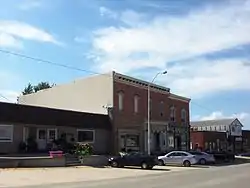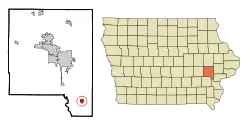Lone Tree, Iowa
Lone Tree is a city in southeastern Johnson County, Iowa, United States. It is part of the Iowa City, Iowa Metropolitan Statistical Area. The population was 1,300 at the 2010 census.
Lone Tree, Iowa | |
|---|---|
 | |
 Location of Lone Tree, Iowa | |
| Coordinates: 41°29′9″N 91°25′36″W | |
| Country | |
| State | |
| County | Johnson |
| Government | |
| • Type | Mayor–council government |
| • Mayor | Jonathan Green |
| Area | |
| • Total | 1.07 sq mi (2.76 km2) |
| • Land | 1.07 sq mi (2.76 km2) |
| • Water | 0.00 sq mi (0.00 km2) |
| Elevation | 725 ft (221 m) |
| Population | |
| • Total | 1,300 |
| • Estimate (2019)[3] | 1,381 |
| • Density | 1,294.28/sq mi (499.83/km2) |
| Time zone | UTC-6 (Central (CST)) |
| • Summer (DST) | UTC-5 (CDT) |
| ZIP code | 52755 |
| Area code(s) | 319 |
| FIPS code | 19-46335 |
| GNIS feature ID | 0458576 |
| Website | http://www.lonetreeiowa.com |
History
Lone Tree was platted by John W. Jayne in 1872.[4] Lone Tree derives its name from a giant elm that grew nearby in the pioneer era and served as a prairie landmark.[5] This elm stood on a slight hill south of town. Local legend has it that the tree was so large, buffalo grazed under its expansive branches. It escaped prairie fires because of the lack of grass around the tree. The tree succumbed to the Dutch Elm disease of the 1960s, although valiant efforts were made to save it. The wood from the tree was used to make a sign denoting the tree's home on the hill southeast of the city limits.
The town had a moment of horrific infamy during the economic crisis of the 1980s. On December 9, 1985 a local farmer, Dale Burr, became distraught over his growing debt. He shot his wife Emily in their home. He then went to Hills Bank & Trust in the neighboring town of Hills and attempted to cash a check and when rebuffed, returned with a shotgun and killed bank president John Hughes. Next on his list was his neighbor Richard Goody, who had recently won a court settlement against Burr's son. When pulled over by Johnson County sheriffs, Burr shot himself fatally.[6] The story was captured in Bruce Brown's book, Lone Tree.
Geography
Lone Tree is located at 41°29′9″N 91°25′36″W (41.485871, -91.426692).[7]
According to the United States Census Bureau, the city has a total area of 1.04 square miles (2.69 km2), all land.[8]
Lone Tree is located alongside Iowa Highway 22.
Demographics
| Year | Pop. | ±% |
|---|---|---|
| 1880 | 217 | — |
| 1900 | 600 | +176.5% |
| 1910 | 782 | +30.3% |
| 1920 | 673 | −13.9% |
| 1930 | 627 | −6.8% |
| 1940 | 651 | +3.8% |
| 1950 | 639 | −1.8% |
| 1960 | 717 | +12.2% |
| 1970 | 834 | +16.3% |
| 1980 | 1,014 | +21.6% |
| 1990 | 979 | −3.5% |
| 2000 | 1,151 | +17.6% |
| 2010 | 1,300 | +12.9% |
| 2019 | 1,381 | +6.2% |
| Source:"U.S. Census website". United States Census Bureau. Retrieved 2020-03-29. and Iowa Data Center Source: | ||
2010 census
As of the census[2] of 2010, there were 1,300 people, 505 households, and 335 families living in the city. The population density was 1,250.0 inhabitants per square mile (482.6/km2). There were 539 housing units at an average density of 518.3 per square mile (200.1/km2). The racial makeup of the city was 94.8% White, 0.7% African American, 0.2% Native American, 0.5% Asian, 1.7% from other races, and 2.1% from two or more races. Hispanic or Latino of any race were 4.0% of the population.
There were 505 households, of which 36.0% had children under the age of 18 living with them, 53.1% were married couples living together, 10.1% had a female householder with no husband present, 3.2% had a male householder with no wife present, and 33.7% were non-families. 26.5% of all households were made up of individuals, and 10.5% had someone living alone who was 65 years of age or older. The average household size was 2.50 and the average family size was 3.06.
The median age in the city was 39.3 years. 26.2% of residents were under the age of 18; 6.2% were between the ages of 18 and 24; 26.2% were from 25 to 44; 26.9% were from 45 to 64; and 14.4% were 65 years of age or older. The gender makeup of the city was 49.2% male and 50.8% female.
2000 census
As of the census[10] of 2000, there were 1,151 people, 459 households, and 323 families living in the city. The population density was 1,165.3 people per square mile (448.9/km2). There were 489 housing units at an average density of 495.1 per square mile (190.7/km2). The racial makeup of the city was 98.96% White, 0.17% African American, 0.09% Asian, 0.26% from other races, and 0.52% from two or more races. Hispanic or Latino of any race were 0.52% of the population.
There were 459 households, out of which 41.6% had children under the age of 18 living with them, 57.5% were married couples living together, 7.6% had a female householder with no husband present, and 29.6% were non-families. 25.1% of all households were made up of individuals, and 11.8% had someone living alone who was 65 years of age or older. The average household size was 2.51 and the average family size was 3.04.
29.4% are under the age of 18, 5.9% from 18 to 24, 31.1% from 25 to 44, 20.2% from 45 to 64, and 13.5% who were 65 years of age or older. The median age was 35 years. For every 100 females, there were 97.1 males. For every 100 females age 18 and over, there were 89.5 males.
The median income for a household in the city was $42,431, and the median income for a family was $50,000. Males had a median income of $35,227 versus $25,815 for females. The per capita income for the city was $18,990. About 4.5% of families and 7.8% of the population were below the poverty line, including 4.9% of those under age 18 and 14.1% of those age 65 or over.
References
- "2019 U.S. Gazetteer Files". United States Census Bureau. Retrieved July 17, 2020.
- "U.S. Census website". United States Census Bureau. Retrieved 2012-05-11.
- "Population and Housing Unit Estimates". United States Census Bureau. May 24, 2020. Retrieved May 27, 2020.
- Aurner, Clarence Ray (1912). Leading Events in Johnson County, Iowa, History, Volume 1. Western Historical Press. p. 168.
- History of Johnson County, Iowa, Containing a History of the County, and Its Townships, Cities and Villages from 1836 to 1882. 1883. p. 710.
- Lamar, Jacob (June 24, 2001). "He Couldn't Manage Any More". Time Magazine. Retrieved 2011-08-22.
- "US Gazetteer files: 2010, 2000, and 1990". United States Census Bureau. 2011-02-12. Retrieved 2011-04-23.
- "US Gazetteer files 2010". United States Census Bureau. Archived from the original on 2012-01-25. Retrieved 2012-05-11.
- "Census of Population and Housing". Census.gov. Retrieved June 4, 2015.
- "U.S. Census website". United States Census Bureau. Retrieved 2008-01-31.
External links
| Wikimedia Commons has media related to Lone Tree, Iowa. |
- City-Data Comprehensive statistical data and more about Lone Tree